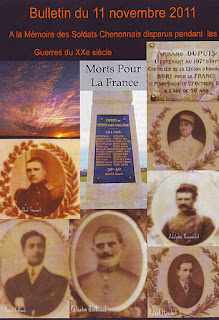Mort pour la France. RIFFAUD Raoul Robert Nestor, Chenonnais - décédé suite maladie contractée en service.
Raoul Riffaud, fourragère de la Médaille Militaire, avec quatre citations, a
été anéanti deux fois. Il été gazé pendant la guerre - la cause de son
décés dix mois aprés l'Armistice. La fourragère telle que nous
la connaissons apparaît en 1916. La circulaire de création en date du 21 avril
de la même année spécifie : "Il est créé un insigne spécial destiné à
rappeler d'une façon permanente les actions d'éclat de certains régiments et
unités formant corps cités à l'ordre de l'armée. Cet insigne sera constitué par
une fourragère aux couleurs de la croix de guerre". En fait dès 1916 de
nombreux corps avaient déjà été cités au moins une fois à l'ordre de l'armée.
Ils se virent donc attribuer la fourragère nouvellement créée. Par la suite,
certains régiments accumulant les actions d'éclat devaient obtenir plusieurs
citations à l'ordre de l'armée. Dans le but de susciter l'émulation et de
fortifier l'esprit de corps, le commandement sentit la nécessité d'établir une
distinction basée sur le nombre de citations obtenues. Cette distinction devait
se traduire par l'adoption de fourragères de couleurs et de formes différentes.
Ces dispositions nouvelles furent officialisées par une circulaire en date du
22 février 1918.
Raoul Riffaud served with the 6th Infantry Regiment in several major battles. He was suffering from the effects of gas which eventually resulted in his death the year after the conclusion of hostilities, aged 24 years. Following the Armistice surviving soldiers were awarded the right to wear the Military Medal with four citations - and the 'Croix de Guerre'. The title 'fourragère' referred to Regiments virtually annialated in combat - in the case of the 6th Regiment on two occasions. The reasoning was to reinforce moral and encourage comradeship - l'esprit de corps'.
The Citation in the regiment's history at the end of the war reads " Hence forth the struggle is finished: without doubt the Regiment welcolmes the news of the Armistice with joy, but also mixed with regret at not being able to trample the enemy under foot by conquering their territory which remained unscatherd from the horrors of the war. Their thoughts also rest with the number of comrades fallen on the field of honour.
La cloche (à droit) à l’église de St. Antoine Chenon. The bell on
the right at the church of St. Anthony at Chenon; (Ma nom - my name) Adrienne – Léotine
J’ai été baptisé par l’évêque d’Angoulême sur la protection de St.
Antoine. I was baptised by the Bishop of Angoulême
En souvenir des morts de la grande guerre 1914-1918, de tous les défunts de
la paroisse et sous la terre. Ma création M. L’Abbé
Augustin Frondefond, Curé, Mon parrain fut M. Adrien Roy, ma marraine
Mmme ; Léotine Chauvaud, veuve Louis Riffaud. In memory
those who died in the Great War 1914-18, all those who have passed away in the
Parish. My creator the Abbot Augustin Frondefond and my sponsors: Adrien Roy, and
Léotinne Chauvaud, widow of Louis Riffaud.
A La Mémoire de Raoul Riffaud. In memory
of Raoul Riffaud.
I weigh 420 pounds and I
sound the note C. Louis Bollée, the bell foundry at Orléans.






Commentaires